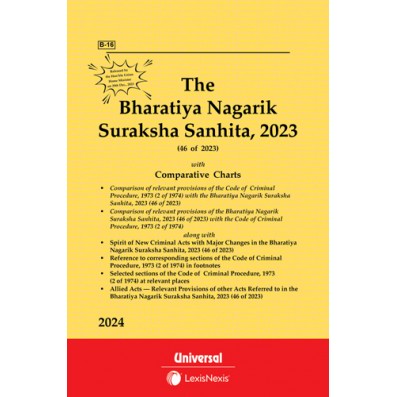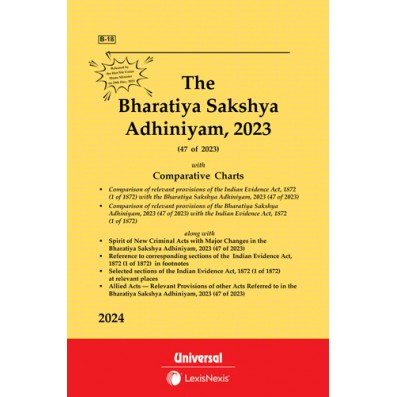New Criminal Laws in India

For years the Indian Penal Code (IPC), Indian Evidence Act and Code of Criminal Procedure have cast a shadow over India’s legal system. While these laws have been the foundation of our justice system, they have struggled to address the complexities of modern India. A new era has dawned and India has taken great steps towards evolution in the field of law with introduction of new criminal laws. The initiative originated in 2020 when the Committee for Reforms in Criminal Laws (CRCL) was established, and chaired by Prof (Dr.) Ranbir Singh. The transformative bills, named as Bharatiya Nyaya Sanhita (BNS), Bharatiya Sakshya Adhiniyam (BSA) and Bharatiya Nagarik Suraksha Sanhita (BNSS) promise to bring about a rebirth by replacing these outdated and erstwhile statutes with new legal frameworks that are specifically designed for the needs of 21 st century India.
Historical Context of Criminal Laws in India
Throughout India’s history, the development of its criminal justice system can be traced across multiple periods including the Vedic age, Delhi Sultanate, Mughal Empire era and up to the present stage. During the Vedic era, principles rooted in Rig Vedic teachings played a role in determining punishments and maintaining order under the guidance of Dharma. Subsequently during the Delhi Sultanate Era, there was an evolution influenced by sources like Smriti and the implementation of Shariat law during that era.
During the time of the Mughal Empire, the Mughals created the Mahakuma e Adalat, a department responsible, for dealing with both criminal and civil cases under Islamic law. However, there were multiple challenges that came with this system. These challenges included the absence of a distinction between the judiciary and the executive branches, inconsistencies, in the application of criminal laws and instances of corruption.
During the Colonial period there was a paradigm shift. The East India Company (EIC) played a key role, in shaping this transformation alongside the introduction of court systems and the establishment of the High Court. These developments set the foundation, for the enactment of codes in the 1860s.
These bills have been revised based on recommendations, from the Standing Committee and had been approved by both houses of Parliament. Hon’ble President gave her assent on December 25th, 2023. The need for reforms and changes in legislation is the realization that the existing laws are outdated remnants of the colonial era reflecting a criminal justice system that aimed to oppress rather than serve justice. Many sections of the old laws have become irrelevant and obsolete requiring an overhaul.
Detailed Overview of the New Criminal Laws
Bharatiya Nyaya Sanhita, 2023
New criminal law Bharatiya Nyaya Sanhita of 2023 is an endeavour to redefine and redirect the code and has replaced the erstwhile Indian Penal Code, 1860. Through amending, repealing and adding sections this law aims to take a nuanced approach towards offenses by imposing penalties on actions that pose a threat to the sovereignty, unity and integrity of India. Additionally, it tackles challenges like terrorism, organized crime, by differentiating between serious and minor offenses and imposing strict punishments for serious offenses. The idea of ‘Community Service’, as a penalty for crimes is now being implemented under the law focusing on a more rehabilitative approach to justice. The recent legislation has added “snatching” as an offense, under Section 304 of the Bharatiya Nyaya Sanhita.
Bharatiya Nagrik Suraksha Sanhita, 2023
The Bharatiya Nagarik Suraksha Sanhita, 2023 aims to refine our Criminal procedure system. By setting timelines for investigations it intends to ensure that justice is more accessible and responsive to the needs of the people. In this new criminal law one notable change can be seen in Section 176 of the Act, which mandates investigation for crimes carrying a punishment of seven (7) years imprisonment or more. This means that appointed experts will be involved in conducting on site investigations. Additionally, Section 173 of the Bharatiya Nagarik Suraksha Sanhita embraces the new digital age by allowing digital methods for trials, inquiries and proceedings. This shift toward documentation and proceedings aligns with advancements in technology and helps streamline legal processes. One revolutionary concept is the implementation of Zero FIRs. According to Section 173 of the Act, individuals have the right to file a First Information Report (FIR) at any police station, for a cognizable offense regardless of its jurisdiction. It states that the FIR must be transferred to the police station, for handling crimes committed in that particular area within a span of 15 days. Crime and Criminal tracking system will be used for benefit of the public.
Bharatiya Sakshya Adhiniyam, 2023
The Bharatiya Sakshya Adhiniyam has replaced the Indian Evidence Act of 1872 resulting in alterations to the structure of Evidence Law. In today’s environment, where technology holds great importance, this new criminal law acknowledges electronic evidence, as any information produced or transmitted by a device or system that can store or recover data. Section 57 of the Bharatiya Sakshya Adhiniyam emphasizes the recognition of electronic records as primary evidence. Moreover, the Act includes provisions that enable the electronic presentation of even oral evidence. This advancement makes it possible for witnesses to testify remotely ensuring that digital records hold the same significance as traditional paper documents. Section 24 of the Act, expands on the idea of joint trials.
Comparison of Old vs New Criminal Laws
| BASIS | OLD CRIMINAL LAWS | NEW CRIMINAL LAWS |
| Laws and Philosophy | The laws were Indian Penal Code, Code of Criminal Procedure, Indian Evidence Act. The philosophy was to provide punitive and retributive justice. | The laws are Bharatiya Nyaya Sanhita, Bharatiya Nagrik Suraksha and Bharatiya Sakshya Adhiniyam. The philosophy is to provide restorative justice focused on rehabilitation and victim centric. |
| Ideology | Developed by Britishers under British oversight and ideology | Built for the Modern India, with focus on ever dynamic legal landscape. |
| Sentencing | There were fixed punishments and penalties specified for various kinds of crimes. | There are provisions for fixed punishments as well as restorative justice provisions like imposition of community service or rehabilitation. |
| Admissibility of Evidence | The acts provided strict and rigid rules for testimonies of witness and sometimes relied upon unreliable circumstantial evidence. Electronic evidence had limited admissibility. | Scope of admissibility was expanded to take into account digital evidence and records and to strengthen investigations. |
| Trial Procedures | Tiring, cumbersome and lengthy procedures due to which due to which people face delays and backlogs in courts. | Aimed at expediting the trial process by implementing time limit and leverage technology to enhance efficiency. |
New Criminal Law Books
The Bharatiya Nagarik Suraksha Sanhita, 2023

This new bare act by Lexis Nexis covers the entire Bharatiya Nagarik Suraksha Sanhita and contains comparisons of both the new act and the old and erstwhile Code of Criminal Procedure, 1973. It also has selected sections of the Code of Criminal Procedure, 1973 and relevant provisions of allied Acts for an ease of understanding.
The Bharatiya Nyaya Sanhita, 2023

This new bare act by LexisNexis is a comprehensive work on the The Bharatiya Nyaya Sanhita and contains a comparison of it with the old Indian Penal Code. It covers the fines and punishments increased in a tabular format. Relevant provisions of allied Acts have also been included for ease of reference. The act has traces of the Indian Penal Code at various places for reference, and is an ideal read for lawyers, students and judges.
The Bharatiya Sakshya Adhiniyam, 2023

This new bare act by Lexis Nexis has covered all bases of the Bharatiya Sakshya Adhiniyam and comprises of a comparison of the Indian Evidence and the Bharatiya Saskhya Adhiniyam along with cross-referencing to the corresponding sections of the old act. Relevant provisions of allied Acts have also been included for ease of reference.
Analysis of New Criminal Laws
India’s criminal laws have sparked a closer look into the difficulties, consequences and objections associated with these changes. A particular area of concern that has garnered increased scrutiny is the increase in the duration of police custody under the Bharatiya Nagarik Suraksha Sanhita. Raising the limit from 15 days to either 60 or 90 days depending on the severity of the offense brings up questions about striking a balance, between law enforcement requirements and protecting civil liberties.
The Bharatiya Nyaya Sanhita introduces a series of broadly defined offences, particularly those pertaining to the security of the state. While the omission of the term “sedition” is notable, its replacement, “Acts endangering sovereignty, unity, and integrity of India,” retains ambiguous wording, contributing to concerns about potential over criminalization. The expansive scope of offences like “organised crime” and “terrorist act” remains, and while attempts have been made to clarify and limit their definitions, questions linger about potential misuse and impact on individuals. Issues like high vacancies, judicial overload, and the need for comprehensive infrastructure development and personnel training for forensic experts and audio-video recording of statements must be diligently tackled to realize the intended efficiencies.
Section 57 of the Bharatiya Sakshya Adhiniyam emphasizes the recognition of electronic records as primary evidence. Moreover, the Act includes provisions that enable the electronic presentation of even oral evidence which is in line with the digital transformation the country is going through.
The new criminal laws also aims to streamline processes through mandatory audio-video recording of search and seizure, the comprehensive impact depends on addressing deep-rooted structural barriers. Achieving the intended reforms demands a holistic approach, encompassing systemic changes, infrastructure development.
Driving Forces Behind the Reforms
These new laws were created as a result of socio- political factors. Demand for justice that prioritizes victims, the need for tech regulations due to the digital revolution and evolving societal values all played a key role. Additionally, there were pressures such as judicial activism highlighting inefficiencies and international obligations as well as diverse opinions from judges. While they acknowledged the potential for improvement they also emphasized the importance of understanding and implementation. It has also been pointed out that justice has been delivered slow in India due to a number of pending cases in various courts. Therefore, there is a need to transition towards a modern legal system.
Conclusion
The analysis of the Bills reveals gaps and shortcomings that warrant attention. The exclusion of the erstwhile section 377 of the IPC by the Bharatiya Nyaya Sanhita (BNS) poses a gap, leaving no specific provision addressing the rape of an adult man. The proposed laws bring in offenses that are worded in a manner particularly concerning the states security. This could potentially result in over-criminalization and unclear legal provisions. Despite these concerns, the legislative initiatives encapsulated in the three Acts underscore India’s commitment to reform its legal and investigative systems. A notable focus on technology and forensic science positions the legal framework in the modern era. The Acts demonstrate a commitment to providing enhanced protection for marginalized and vulnerable segments of society, aligning the criminal justice system with current needs and values.
FAQS
What are the major new criminal laws introduced in India in 2023?
The Bharatiya Nyaya Sanhita (BNS), Bharatiya Nagarik Suraksha Sanhita (BNSS), and Bharatiya Sakshya Adhiniyam (BSA).
How do the new criminal laws differ from the previous ones?
The new criminal laws bring substantial changes, addressing contemporary challenges. Home Minister Amit Shah introduce provisions for Sedition to be treated as treason, new duration for punishments, e-trials, redefine the concept of police custody, incorporate technological advancements in investigations, and establish deadlines for various legal processes.
Why were these changes in the criminal laws necessary?
The changes were deemed necessary to modernize the criminal justice system, aligning it with evolving societal needs and technological advancements.
Are there any controversial aspects of the new laws?
Controversies surround aspects such as the extension of police custody duration, potential misuse of expanded powers, and concerns about over criminalization. The repeal of certain sections, like the erstwhile section 377 addressing rape of an adult man, has sparked discussions about the completeness and effectiveness of the new laws.
How can the public access more information about these new laws?
To access detailed information about these new laws, the public can refer to official government sources, legal databases, and the official websites of legislative bodies, books and articles of lawyers and law firms. Government announcements, press releases, and legal commentaries can provide insights of the new laws.

